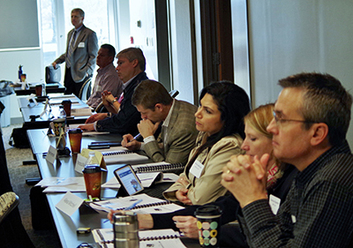February 28, 2014
Innovation of the Month: Three-Dimensional Modeling
Through Every Day Counts, the Federal Highway Administration is offering opportunities for highway agency staff and other transportation stakeholders to learn about using three-dimensional engineered models for construction projects.
FHWA launched a series of free webinars in 2013 on 3-D modeling. Information on registering for future webinars and recordings of the first two sessions are available here. The final five are scheduled for the following dates in 2014:
- April 2 - Applications of 3-D Models on the Construction Site
- May 7 - Managing and Sharing 3-D Models for Construction
- September 10 - Overcoming Impediments to Using 3-D Engineered Models for Construction
- October 15 - Requiring 3-D Engineered Models for Construction
- November 19 - The Future: Adding Time, Cost and Other Information to 3-D Models
FHWA also offers state agencies free workshops to help them take the next steps in implementing 3-D modeling. The Arkansas State Highway and Transportation Department held the first in January.
The one-day events include presentations, hands-on activities, discussion on procedures and technology, and networking opportunities. For information on organizing a workshop, contact David Unkefer at david.unkefer@dot.gov or (404) 562-3669.
Colorado Asphalt Conference Highlights EDC Technologies

Arkansas 3-D Engineered Models for Construction Workshop
Last week’s Rocky Mountain Asphalt Conference & Equipment Show in Denver included sessions on intelligent compaction and warm-mix asphalt. FHWA also displayed a warm-mix asphalt exhibit that was one of the conference highlights, according to Thomas Peterson, Colorado Asphalt Pavement Association executive director.
For more than 40 years, contractors, suppliers, government agency representatives and consultants from the Rocky Mountain region have come to the annual Colorado conference to discuss advancements in asphalt pavements.
Michigan Plans Bridge Slide
A Michigan Department of Transportation project on I-96 at M-50 in Lowell will use two EDC innovations to reconstruct and widen this busy interchange. Using slide-in bridge technology for the first time means the overpass will be out of service for significantly less time than with typical construction methods. Traffic will travel on the old bridge while the new bridge is built on temporary supports and move to the new bridge while the old bridge is demolished. Using construction manager/general contractor project delivery allows the agency to involve the contractor early in the process to make sure each stage of the project is constructible and has minimal impact on travelers. The project is set to begin in 2014.
Oregon Builds Diverging Diamond Interchange
Construction began this month on the $73 million Fern Valley Interchange project to replace the bridge over I-5 in Phoenix, Ore. The Oregon Department of Transportation chose a diverging diamond design to replace the old bridge to reduce footprint impacts and right-of-way costs and increase capacity and safety. The diverging diamond design, which reduces the number of traffic signals, will be the first of its kind on the West Coast when the project is finished in 2016.


